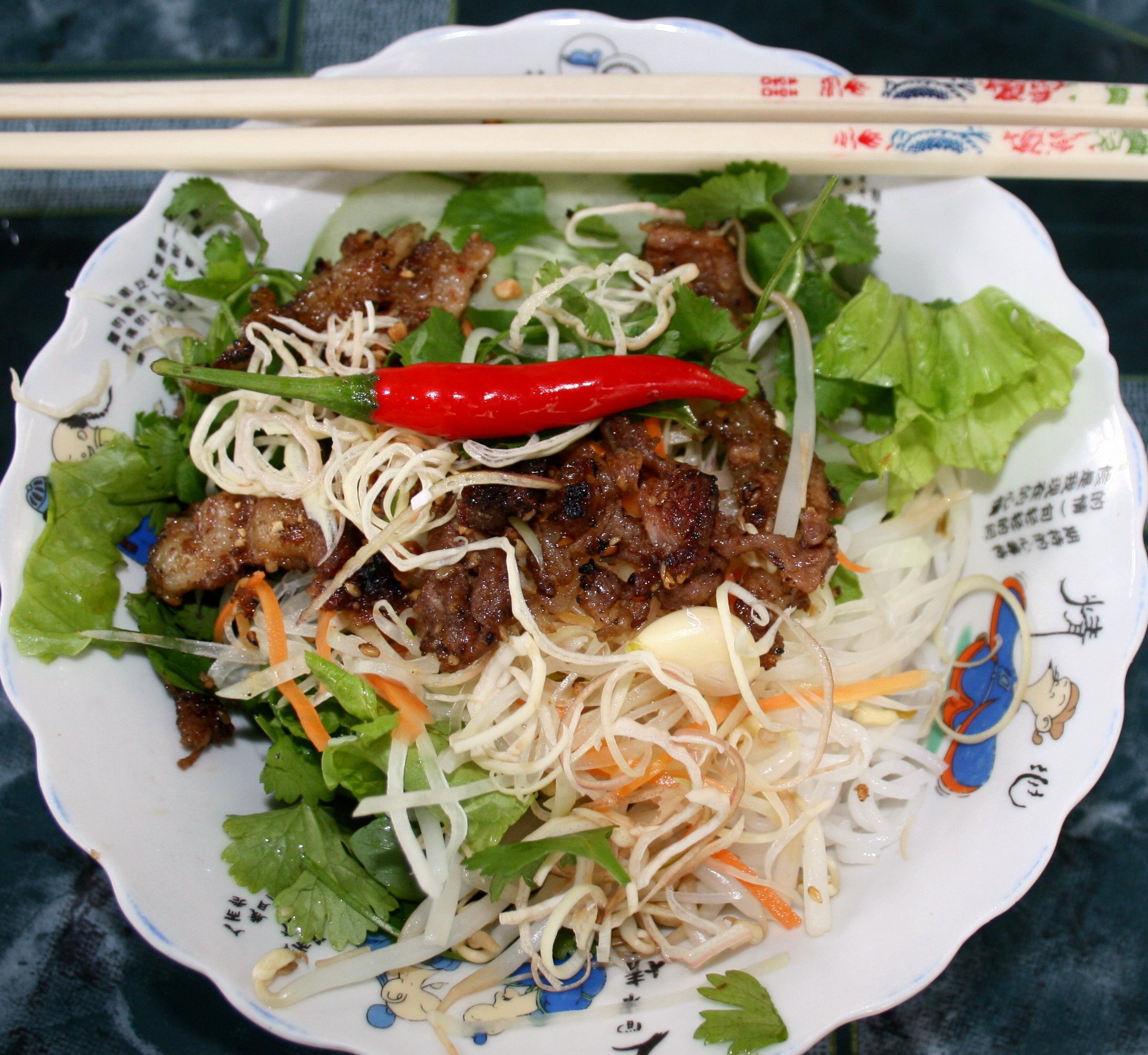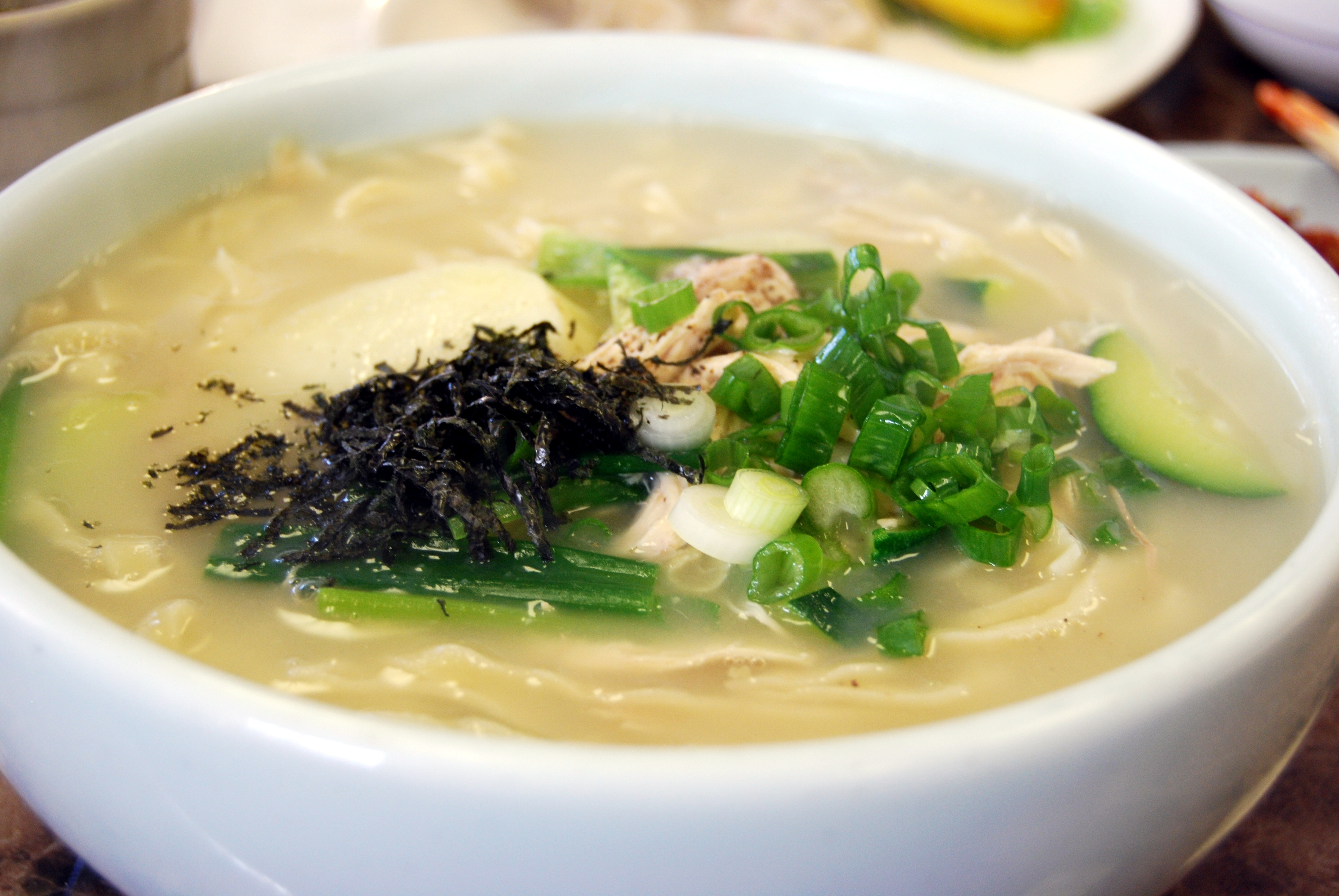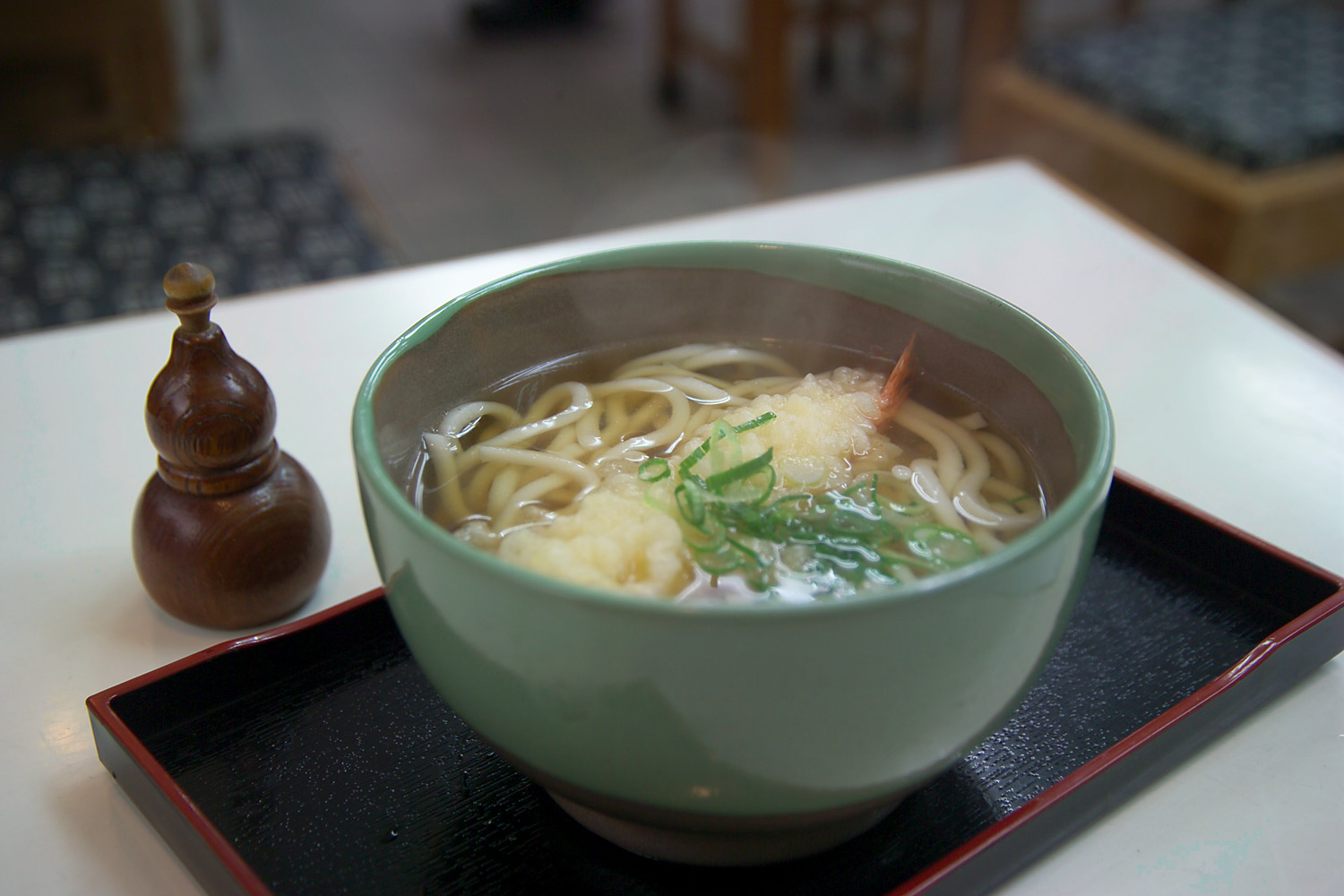|
Noodle
Noodles are a type of food made from unleavened dough which is either rolled flat and cut, stretched, or extruded, into long strips or strings. Noodles are a staple food in many cultures and made into a variety of shapes. The most common noodles are those derived from either Chinese cuisine or Italian cuisine. Chinese noodles are known by a variety of different names, while Italian noodles are known as pasta. While long, thin strips may be the most common, many varieties of noodles are cut into waves, helices, tubes, strings, or shells, or folded over, or cut into other shapes. Noodles are usually cooked in boiling water, sometimes with cooking oil or salt added. They can also be steamed, pan-fried, deep-fried, or baked. Noodles are often served with an accompanying sauce or in a soup, the latter being known as noodle soup. Noodles can be refrigerated for short-term storage or dried and stored for future use. Etymology The word for noodles in English was borrowed in the 1 ... [...More Info...] [...Related Items...] OR: [Wikipedia] [Google] [Baidu] |
Noodle Soup
Noodle soup refers to a variety of soups with noodles and other ingredients served in a light broth. Noodle soup is a common dish across East Asia, Southeast Asia and the Himalayan states of South Asia. Various types of noodles are used, such as rice noodles, wheat noodles and egg noodles. Varieties East Asia China There are myriad noodle soup dishes originating in China, and many of these are eaten in, or adapted in various Asian countries. * Ban mian (板麵) – Hakka-style, flat-shaped egg noodles in soup. * Chongqing noodles * Cold noodle (冷面/冷麵) – Shanghai-style, flat noodle stirred with peanut butter sauce, soy sauce and vinegar, served cold. * Crossing-the-bridge noodles () – ingredients are placed separately on the table, then added into a bowl of hot chicken stock to be cooked and served. The ingredients are uncooked rice noodles, meat, raw eggs, vegetables and edible flowers. The stock stays warm because of a layer of oil on top of the bowl. Typical cuisi ... [...More Info...] [...Related Items...] OR: [Wikipedia] [Google] [Baidu] |
Chinese Noodles
Chinese noodles vary widely according to the region of production, ingredients, shape or width, and manner of preparation. Noodles were invented in China, and are an essential ingredient and Staple food, staple in Chinese cuisine. They are an important part of most regional cuisines within China, and other countries with sizable overseas Chinese populations. Chinese noodles can be made of wheat, buckwheat, rice, millet, maize, oats, Acorn, acorns, kudzu, Ulmus pumila, Siberian elm, soybeans, mung beans, Yam (vegetable), yams, cassava, potatoes, sweet potatoes, and meats such as fish as food, fish and shrimp and prawn as food, shrimp. There are over 1,200 types of noodles commonly consumed in China today, with tens of thousands of noodle dish varieties prepared using these types of noodles. Chinese noodles have entered the cuisines of neighboring East Asian countries such as Korea, Japan, and Mongolia, as well as Southeast Asian countries such as Malaysia, Singapore, Indonesia, V ... [...More Info...] [...Related Items...] OR: [Wikipedia] [Google] [Baidu] |
Udon
Udon ( or ) is a thick noodle made from wheat flour, used in Japanese cuisine. There are a variety of ways it is prepared and served. Its simplest form is in a soup as with a mild broth called made from dashi, soy sauce, and mirin. It is usually topped with thinly chopped scallions. Other common toppings include prawn tempura, (mixed tempura fritter), (sweet, deep-fried tofu pouches), (sliced fish cake), and spice added to taste. Standard broth differs by region. Dark soy sauce is added in eastern Japan, while light soy sauce is added in the west. Instant noodles are often sold in two (or more) versions accordingly. More unusual variants include stir-fried and curry udon made with Japanese curry. It is often used in or Japanese hot pot. Dishes Udon noodles are boiled in a pot of hot water. Depending on the type of udon, the way it is served is different as well. Udon noodles are usually served chilled in the summer and hot in the winter. In the Edo period, the thicker ... [...More Info...] [...Related Items...] OR: [Wikipedia] [Google] [Baidu] |
Lamian
Lamian (; "pulled noodles") is a type of soft wheat flour Chinese noodles, Chinese noodle that is particularly common in Northern and southern China, northern China. Lamian is made by twisting, stretching and folding the dough into strands, using the weight of the dough. The length and thickness of the strands depends on the number of times the dough is folded. History The unique method of making lamian noodles originated in China. The earliest description of making lamian noodles with the pulling technique is found in the ''Songshi Yangsheng (Daoism), Yangsheng Bu'' (宋氏養生部), a dietary manual written in 1504 by Song Xu (宋詡), an agriculturalist and gastronomer of the Ming dynasty. Description The hand-making process involves taking a lump of dough and repeatedly stretching it to produce many strands of thin, long noodle. Literally, ''lā'', (拉) means to pull or stretch, while ''miàn'' () means noodle. There are several styles of twisting the dough but ... [...More Info...] [...Related Items...] OR: [Wikipedia] [Google] [Baidu] |
Chinese Cuisine
Chinese cuisine comprises cuisines originating from Greater China, China, as well as from Overseas Chinese, Chinese people from other parts of the world. Because of the Chinese diaspora and the historical power of the country, Chinese cuisine has profoundly influenced many other cuisines in Asia and beyond, with modifications made to cater to local palates. Chinese food staples such as rice, soy sauce, noodles, tea, chili oil, and tofu, and utensils such as chopsticks and the wok, can now be found worldwide. The world's earliest eating establishments recognizable as Restaurant, restaurants in the modern sense first emerged in Song dynasty China during the 11th and 12th centuries. Street food became an integral aspect of Chinese food culture during the Tang dynasty, and the street food culture of much of Southeast Asia was established by workers imported from China during the late 19th century. The preferences for seasoning and Chinese cooking techniques, cooking techniques in ... [...More Info...] [...Related Items...] OR: [Wikipedia] [Google] [Baidu] |
Pasta
Pasta (, ; ) is a type of food typically made from an Leavening agent, unleavened dough of wheat flour mixed with water or Eggs as food, eggs, and formed into sheets or other shapes, then cooked by boiling or baking. Pasta was originally only made with durum, although the definition has been expanded to include alternatives for a gluten-free diet, such as rice flour, or legumes such as beans or lentils. Pasta is believed to have developed independently in Italy in the Middle Ages, Italy and is a staple food of Italian cuisine, with evidence of Etruscan civilization, Etruscans making pasta as early as 400 BCE in Italy. Pastas are divided into two broad categories: dried () and fresh (Italian: ). Most dried pasta is produced commercially via an Food extrusion, extrusion process, although it can be produced at home. Fresh pasta is traditionally produced by hand, sometimes with the aid of simple machines.Hazan, Marcella (1992) ''Essentials of Classic Italian Cooking'', Knopf, F ... [...More Info...] [...Related Items...] OR: [Wikipedia] [Google] [Baidu] |
Lajia
Lajia () is a Bronze Age archaeological site in the upper reaches of the Yellow River, on the border between the Chinese provinces of Gansu and Qinghai. As at other sites of the Qijia culture (c. 2300–1500 BCE), the people of Lajia had an agricultural economy based primarily on millet cultivation and sheep herding. They also kept pigs for use in ritual activities, including making oracle bones, and experimented with a high temperature-fired pottery described as proto-porcelain. The world's oldest known noodles were discovered at the site in 2005. A natural disaster buried the site and killed many of its inhabitants in around 1920 BCE, but archaeologists continue to debate the exact cause of the catastrophe. Background Lajia is associated with the Qijia culture, an archaeological culture of northwestern China dated to the late Neolithic and early Bronze Age periods (c. 2300–1500 BCE). Excavations at the site have unearthed various Qijia artifacts, including pottery, rings ... [...More Info...] [...Related Items...] OR: [Wikipedia] [Google] [Baidu] |
Mung Bean
The mung bean or green gram (''Vigna radiata'') is a plant species in the legume family.Brief Introduction of Mung Bean. Vigna Radiata Extract Green Mung Bean Extract Powder Phaseolus aureus Roxb Vigna radiata L R Wilczek. MDidea-Extracts Professional. P054. http://www.mdidea.com/products/proper/proper05402.html The mung bean is mainly cultivated in East, Southeast, and South Asia. It is used as an ingredient in both savoury and sweet dishes. Names The English names " mung" or " mungo" originated from the Hindi word (), which is derived from the Sanskrit word (). It is also known in Philippine English as " mongo bean". Other less common English names include "golden gram" and "Jerusalem pea". In other languages, mung beans are also known as * Persian : ''maash'' (ماش) *Urdu- ''mūng'' (مونگ) *Hindi- ''mūng'' (मूंग) * Punjabi- ''mūng'' (ਮੁੰਗ) * Gujarati-''mag'' (મગ) * Marathi- ''hirve mug'' (हिरवे मूग) *Konkani- ''mugā' ... [...More Info...] [...Related Items...] OR: [Wikipedia] [Google] [Baidu] |
Buckwheat
Buckwheat (''Fagopyrum esculentum'') or common buckwheat is a flowering plant in the knotweed family Polygonaceae cultivated for its grain-like seeds and as a cover crop. Buckwheat originated around the 6th millennium BCE in the region of what is now Yunnan, Yunnan Province in southwestern China. The name "buckwheat" is used for several other species, such as ''Fagopyrum tataricum'', a domesticated food plant raised in Asia. Despite its name, buckwheat is not closely related to wheat. Buckwheat is not a cereal, nor is it a member of the Poaceae, grass family. It is related to sorrel, Polygonum, knotweed, and rhubarb. Buckwheat is considered a pseudocereal because the high starch content of the seeds enables buckwheat to be cooked and consumed like a cereal. Etymology The name "buckwheat" or "beech wheat" comes from its tetrahedral seeds, which resemble the much larger seeds of the beech nut from the beech, beech tree, and the fact that it is used like wheat. The word may be a ... [...More Info...] [...Related Items...] OR: [Wikipedia] [Google] [Baidu] |
Italian Cuisine
Italian cuisine is a Mediterranean cuisine#CITEREFDavid1988, David 1988, Introduction, pp. 101–103 consisting of the ingredients, recipes, and cooking techniques developed in Italy since Ancient Roman cuisine, Roman times, and later spread around the world together with waves of Italian diaspora. Significant changes Columbian exchange, occurred with the colonization of the Americas and the consequent introduction of potatoes, tomatoes, capsicums, and maize, as well as sugar beet—the latter introduced in quantity in the 18th century. It is one of the best-known and most widely appreciated Gastronomy, gastronomies worldwide. Italian cuisine includes deeply rooted traditions common throughout the country, as well as all the diverse Regional cuisine, regional gastronomies, different from each other, especially between Northern Italy, the north, Central Italy, the centre, and Southern Italy, the south of Italy, which are in continuous exchange. Many dishes that were once region ... [...More Info...] [...Related Items...] OR: [Wikipedia] [Google] [Baidu] |
Starch
Starch or amylum is a polymeric carbohydrate consisting of numerous glucose units joined by glycosidic bonds. This polysaccharide is produced by most green plants for energy storage. Worldwide, it is the most common carbohydrate in human diets, and is contained in large amounts in staple foods such as wheat, potatoes, maize (corn), rice, and cassava (manioc). Pure starch is a white, tasteless and odorless powder that is insoluble in cold water or Alcohol (chemistry), alcohol. It consists of two types of molecules: the linear and helix, helical amylose and the branched amylopectin. Depending on the plant, starch generally contains 20 to 25% amylose and 75 to 80% amylopectin by weight. Glycogen, the energy reserve of animals, is a more highly branched version of amylopectin. In industry, starch is often converted into sugars, for example by malting. These sugars may be fermentation, fermented to produce ethanol in the manufacture of beer, whisky and biofuel. In addition, sugars ... [...More Info...] [...Related Items...] OR: [Wikipedia] [Google] [Baidu] |
Qijia Culture
The Qijia culture (2400 BC – 1600 BC) was an early Bronze Age culture distributed around the upper Yellow River region of Gansu (centered in Lanzhou) and eastern Qinghai, China. It is regarded as one of the earliest bronze cultures in China. The Qijia Culture is named after the Qijiaping Site (齐家坪) in Gansu Province. Prior to Qijia culture, in the same area there existed Majiayao culture that was also familiar with metalwork. At the end of the third millennium B.C., Qijia culture succeeded Majiayao culture at sites in three main geographic zones: Eastern Gansu, Middle Gansu, and Western Gansu/Eastern Qinghai. The Qijia culture benefited from the warm and humid climatic conditions from the Late Glacial to the Middle Holocene, which led to flourishing agricultural production and rapid population growth. These conditions changed with the aridification of the Late Holocene, provoking material and cultural decline. Research Johan Gunnar Andersson discovered the initial si ... [...More Info...] [...Related Items...] OR: [Wikipedia] [Google] [Baidu] |










